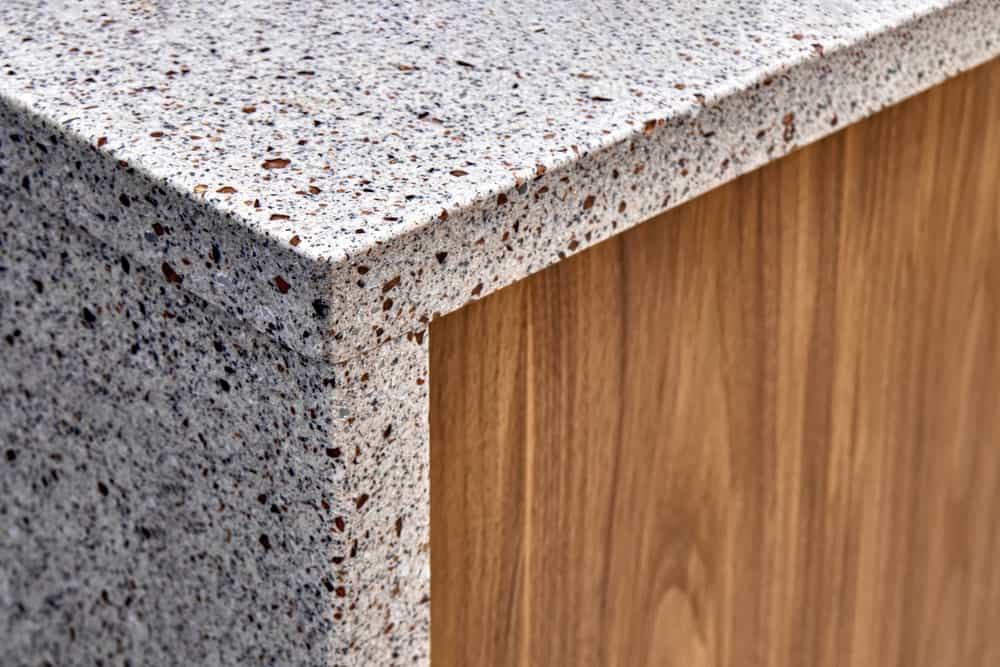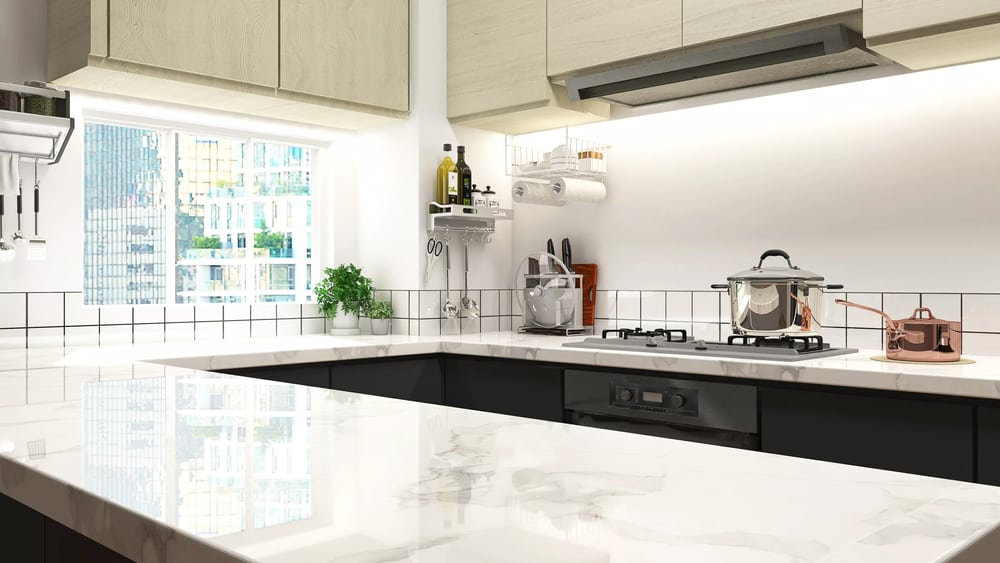If you’re like me, you think a solid surface countertop is the opposite of a hollow countertop. Turns out that’s not quite right … oops! So what are solid surface countertops? They’re a type of synthetic stone countertop that’s cheaper than natural stone but easily passes for the real thing. They’re non-porous, which is a top countertop quality! Let’s learn more about them.
Wood, Stone, and Synthetics
The best countertops are made of marble, with granite as an affordable alternative. But both these options are pricier than solid surface countertops. It’s not just the cost that makes solid surfaces appealing. They have lots more benefits for kitchen countertops, but their biggest selling point is functionality. Let’s dig into their history and find out what they’re good for.
Unlike marble or granite which comes in tiles or solid stone slabs, solid surface countertops are made from composite materials fused with resins. The main component is ATH: alumina trihydrate. The resins that hold these particles together could be epoxy, acrylic, or polyester. The mixture also has various pigments to effectively mimic that natural stone appearance.
The first solid surface countertops were manufactured by DuPont around 1967. They used the trade name Corian, and lots of people still use the brand generically to refer to any type of solid surface countertop. But the original Corian patent expired, so lots of other companies use the technology to develop their own brands of solid surface countertops e.g. Swanstone.
Formica is another example of Corian-adjacent brands, though Formica initially used the same techniques to mimic wood, not stone. It’s more of a laminate than a composite, but newer versions can be printed to simulate stone, fabric, gem, or metal patterns. But let’s get back to Corian and its stony relatives. The biggest benefit of these materials is antimicrobial.
Long-term Countertop Costs
When you invest in a natural stone countertop, you’re channeling beauty, elegance, and style. But marble countertops are also high maintenance. The stone is naturally porous, so it’s susceptible to acidic foods like tomatoes, citrus, and red wine. This means you have to be cautious with your countertops, and you’ll panic any time you spot a spill, scratch, or etching.
Plus, you have to reseal your marble countertops every six months or so. That gets expensive! In comparison, solid surface countertops have resins built-in, so you don’t have to seal them once you install them. Curiously though, the initial cost of marble and Corian are about the same, but you’ll still save money on maintenance, and your stress levels will be far lower.
Granite goes for less than both Corian and marble, but not by much. The price difference is roughly $20 per square foot. And interestingly, granite still has to be resealed 3 or 4 times a year. Resealing can cost around $100 to $200, it’s a significant expense! This makes Corian a better option than both granite and marble. It never needs resealing and is far less fussy.
So why would you opt for natural stone when solid surface countertops make so much more sense? Well, marble has that high-end look and it adds value to your property. Solid surface countertops are cheaper in the long run, and they’re fine for the average home, but they still look lower in grade compared to natural stone slabs. Corian does have other benefits though.
Benefits of Solid Surface Countertops

The biggest advantage is right there in the name. Solid surface countertops seem … solid! They come in sheets that can be joined to make any shape, and the seams are invisible if they’re done the right way. You can cover a much larger surface with barely any joinery marks. For the same budget as marble, you get far more flexibility in colors and designs.
You won’t have to audit your kitchen for acidic items, and solid surface countertops are far easier to maintain. But how do they achieve that continuous surface? After joining separate sheets, the joint is cured and then flattened with a machine. This same technique is useful when you want a thicker countertop because you can compact multiple layers of Corian if you like.
These solid seams protect the countertop from bacteria, and the intrinsic resin keeps your countertops permanently impermeable. This means solid surface countertops are waterproof so you can extend them into sinks and backsplashes, even in bathrooms. These countertops do scratch and crack, but they’re less fragile than stone and significantly cheaper to repair.
Solid surface countertops are engineered composites. So if you don’t like that marble or granite look, order Corian in metallic, sparkling, pearlescent, or solid tones. And while most solid surface countertops come in sheet form, you can find other consistencies molded into various shapes. It’s a common tactic for tubs, sinks, or decorative elements on countertops.
The Quartz vs. Solid Surface Countertops
While we generally compare solid surface countertops to natural stone, it would be fairer to pit it against a similar material. Its closest practical rival is quartz, which is also a type of engineered composite. The difference is that quartz is built off crushed stone while the foundation for Corian is ATH. This quartz is a mix of marble, granite, and recycled items.
The recycled materials include mirrors, silica, and ceramics. All these particles are fused with a binder made of cement or polymers. Like Corian, quartz is non-porous and doesn’t need resealing. But for the initial installation, quartz costs more than Corian. That said, quartz is more durable than Corian, and it’s more heat-resistant so it’s a better choice for kitchens.
It sounds like the main disadvantage of solid surface countertops is that they scratch easily. But you can buff out the scratches as soon as you spot them. All you need is an orbital sander and a lot of practice. You can’t install the countertop yourself though – budget for fabrication costs. And if your countertop is regularly exposed to extreme heat, quartz is a smarter choice.
Next question – practically speaking, should you go with Formica or Corian? Both can have stone-like appearances, but Formica is a laminate slapped onto a fibreboard base, so it’s closer to wood. Corian – and its derivatives – has a base that’s closer to stone because the sheets comprise fused layers of ATH. Meanwhile, quartz countertops are stone all the way.
The Battle of the Composites
What about tile countertops – how do they compare to solid surface options? Tiles resist scratches better, and when the surface does get compromised, the damage isn’t as visible. But tiles have grouting between their pieces while Corian has that even, seamless finish. The grouting in tile also lacks the anti-bacterial quality you get from your quartz or solid surfaces.
Tile is way cheaper, and you can safely place hot pans on it. Quartz can withstand scorching utensils too, but if you opt for a solid surface countertop, the heat from your cookware will damage it. Also, in the long-term, Corian countertops have the lowest resale value. For this article, we’ve used Corian to generically represent all brands of solid surface countertops.
But there’s a curious difference. Some solid surfaces are acrylic while others are polyester, and the polyester options are cheaper. Acrylic options are typically injected into molds, so they’re more popular for sinks and structural surfaces. Both these countertop materials have ATH, a fine white powder derived from bauxite. This sedimentary rock is high in aluminum.
The powder is densely packed with resins to produce that smooth, solid form and texture. Over 30% of solid surface countertops are resin. In contrast, a quartz countertop is about 90% crushed stone with only 10% resin, so it can handle higher temperatures and lasts longer, but its texture isn’t as fine or consistent as Corian. Its resale value is higher though.
Cons of Solid Surface Countertops
The key disadvantage of solid surface countertops is you can cut into them. The marks won’t be as deep (or visible) as marble or wood, but it’s something to consider. One idea is to have a designated cutting section. Your fabricators can use the leftover sink cut-out to make this cutting board and plant it somewhere on your countertop. The second Corian con is heat.
We’ve mentioned that it can’t handle hot pots or live flames, so be careful where you place your saucepans when you yank them off the stove! Other than that, solid surface countertops trump other materials. You can put any kind of food on it, and you don’t have to scour Wholefoods for organic, non-acidic detergents. Also, it’s easy to find a pattern that you like.
Homeowners hear a lot about Corian’s resale value (or lack thereof). But it’s crucial that Corian doesn’t lower the value of your home. It won’t appreciate like quartz or marble but it won’t diminish your sale price either. And it can handle hard knocks and heavy weight so you can safely tenderize meat or pound pizza dough, something you’d never try on marble.
As we wind up, let’s talk texture. Marble and granite countertops are made of solid stone slabs. Quartz has high-end stone components, but they’re crushed and fused. Laminate countertops like Formica have layers that can break, crumble, or warp. But solid surface counters are made of mineral dust and adhesives. The consistency is identical throughout.
The Core of Your Workspace
Commercial kitchens opt for stainless steel surfaces while high-end homes default to marble. And while lots of mid-level homes are going granite or quartz, Corian is increasingly popular. But what are solid surface countertops? They’re a type of engineered composite made from ATH and various resins. These countertops are pretty and non-porous, with low resale value.
What kind of countertops do you have at home? Show us photos in the comments section!

Aw, this was an incredibly nice post. Spending some time and actual effort to make a very good article… but what can I say… I procrastinate a whole lot and never seem to get nearly anything done.